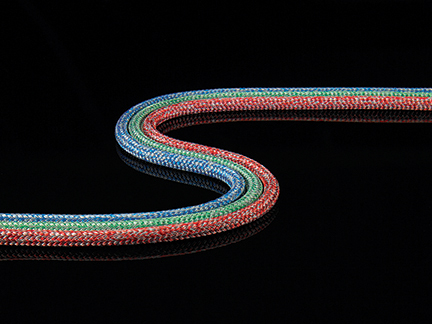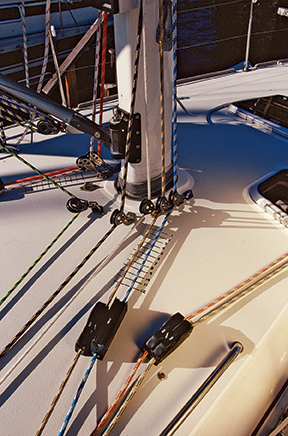Lines run here, there and everywhere on a sailboat. It’s worth knowing what their properties are and how best to use them. (September 2014)
A few years ago, as I was wandering the docks and checking out the fleet of Open Class 60s, I noticed that there weren’t any shackles on the deck of one particularly well-prepared boat. Webbing had replaced the stainless steel. Of course, there were other innovative gadgets and systems, but it struck me that even the simple shackle was being tossed aside for a more efficient replacement. That, as it turns out, was just the very tip of the iceberg. Radical changes had been afoot!
The keys to these changes are the high modulus fibers that are now available, and creative thinking by some of the leading riggers and rope manufacturers of the world. High modulus merely means resistance to stretch. One rigger who specialized in the use of advanced line told me that everything is now measured in “stretch equivalency.” Of course, each of the particular fibers have other critical characteristics, but a fiber’s tensile strength is the first consideration on how it may be used in a particular application.
There are three components to fiber elongation. Elastic elongation, in which a line that is loaded with several hundred pounds will stretch a given amount and immediately spring back part of that amount that has been stretched when the load has been removed. Hysteresis is a type of elongation that will give back a little more of the stretched amount over a period of time. In permanent elongation a line will, to a certain extent, be permanently stretched. Yale offers that the best way to break in a new polyester line and make it more stable is to make one end fast to a secure hard point on the boat and winch the line very tight. Then leave it there over a period of time to remove the permanent component of elongation that is characteristic of traditional polyester ropes.
Stretchiness in some lines, such as lazy jacks or dock lines, may not only be tolerable, it may even be desirable. But the cutting edge applications that have taken place are in the high tensile strength, high modulus lines.
Kevlar 49 or the higher strength Kevlar 149 has been thought of as a baseline fiber when considering high tensile strength line. On competitive monohulls they have been used in runners and check stays. It was only a few decades ago that the use of Kevlar in rigging was considered advanced thinking. Now it’s a baseline and quickly losing that status to more advanced line.

One of the problems with Kevlar is windage. By using Kevlar over stainless rod, weight is saved, but the windage can still be further reduced in some applications by using alternative fibers. Since everything is considered in stretch equivalency, PBO provides another option. With a much higher modulus, PBO is roughly twice the strength of Kevlar 149. Half of the fiber bundle cross-sectional surface area can be used to provide the same strength.
PBO has its own set of problems, however. Because the modulus is so high, fibers don’t stretch or “creep” to take up proportional loads. Creep is the elongation of the fibers that occurs over time and is sometimes associated with Spectra in various applications. Loading the PBO fibers evenly at the terminal ends is difficult and care must be given to ensure even loading at the outset. Because attaining even load distribution at the end fitting is so tricky, PBO failures usually occur at the terminals. As with most high modulus fibers, knots critically reduce the overall strength of the line, and care must be given in going around corners to load the fibers evenly.
Splices and knots can weaken lines depending on the type of the line, the type of the knot and the quality of the splice. Line becomes significantly weaker in a knot because the outer strands in a bend are forced to carry most of the load while the inner strands take little or none of it. A bowline knot can reduce the strength of the rigging at the knot by 55 percent for high modulus line and as much as 30 percent for polyester line. The less a fiber can stretch before it fails, the greater the percentage of its strength is reduced in a knot. Because each knot has its own characteristic bends and turns—some more acute than others—each knot also causes more or less loss of strength in a high modulus line. An inside clove hitch reduces the strength less than a bowline, and a fisherman’s knot less than that. A properly executed splice meanwhile can retain up to 85 or 90 percent of the line’s strength when spliced around a traditional shackle bale.
Other characteristic problems that PBO has are that it breaks down in visible light, and it is even worse in inter-fiber chafe than Kevlar. To ensure continued reliability, all lines need to be properly cared for, but some are more fragile than others. Chafe is probably the most common cause for premature aging of running rigging in particular. Bad sheet leads or afterguys chafing against life lines, lines running over metal such as the bottom of the boom or against the cap shrouds, or halyards rubbing against the leading edge of the spreaders for extended periods of time are common chafe points. There are numerous others. Repeated soaking in salt water and drying without rinsing in fresh water can allow salt crystals to chafe the fibers. And a high salt content can add both to higher moisture retention and to early retirement for the line.
One particularly interesting and cutting edge way in which PBO has been used is in the luff of roller furling headsails. Run as a continuous loop from the roller furler at the tack point to the swivel at the masthead, the sail rolls up around the loop that is all of the way up its luff. Because the PBO fiber is so strong, the rod headstay can be eliminated. To make it possible for the sail to roll and unroll smoothly, the distance between the sides of the loop must be sufficiently wide and the luff must be properly tensioned, thereby delivering the torque from the roller furler at the tack to the swivel at the masthead. The difficult part is to get sufficient torque to the upper swivel to overcome its friction, but proper tensioning and width in the loop are providing the solutions to that problem. Gunboat catamarans use a similar furling headstay replacement.
As with the earlier Open Class 60 that was on the dock years ago, the means of attaching rigging to the deck and to blocks is increasingly made with lashings and loops consisting of high modulus fibers. One rigging company came out with a product they call “LOUPS™”. Now made by Harken, they are available through West Marine. Made from Dyneema, Loups can be used to replace stainless steel shackles in most applications. A stainless steel shackle can weigh as much as 11 times more than a LOUPS™ in the same application while the LOUPS retains the same strength and reliability. To ensure equal loading of all parts in the LOUPS and to increase the efficiency of the Dyneema itself, Yale has developed a proprietary heating and loading system. Using this system ensures maximum performance and longevity of the structure.
Visually, the loops and lashings appear like a high tech throwback to an earlier era. Turnbuckles and shackles are vanishing, and lashings and whippings are returning. In some cases the lashings connect carbon fiber chainplates to high modulus standing rigging. Hydraulic rams are used to pump down the shrouds while lashings are adjusted and re-adjusted, and then the hydraulic rams are removed and stored in a container. The lashings are often Vectran or Spectra, which tends to perform better in tight radiuses due to its characteristic to creep slightly.
Creep had been one of the persistent problems with earlier synthetic lines. With some grades of Spectra, however, creep to rupture could occur at 95 percent of a line’s designed maximum load, so there is a relatively low amount of stretch to failure when compared to those earlier synthetics. The application in which a line is intended to be used can be critically important to achieving a desired result.
The demands placed upon running rigging are different to those placed upon standing rigging. Some lines and fibers are better used in various applications than others. All of the synthetic fibers have their own unique sets of properties such as chafe resistance, tensile strength to weight ratios, the degree to which they will creep or elongate under load, whether they tend to be hydrophobic, retaining less moisture, or hydroscopic. And some fibers, such as PBO are more prone to UV degradation than others, such as Vectran. Some fibers can gain up to eight percent in weight from the moisture in the air—even on a nice, sunny day with 60 percent relative humidity. Some lines are blends of higher modulus, high tensile strength fibers such as Spectra or Vectran combined with other fibers such as polyester. And there are a number of polyester fibers, Dacron is only one particular type of polyester produced by DuPont. Even Spectra has a few different types including 900 and 1000. Spectra 1000, while costing somewhat more, also has approximately 20 percent more strength for the same diameter of Spectra 900, and Spectra 1000 also has lower stretch. Adding to the alphabet soup of synthetic lines, Dyneema, a trademark name for an essentially Spectra line, comes in SK 75 (roughly equivalent to Spectra 1000) and SK 60 (roughly equivalent to Spectra 900).
Braided PBO lines are being used in halyards, but due to PBO’s weakness in chafe, it should not be used in conjunction with halyard locks, and special care should be given to the types of sheaves the lines run around. The fibers hydrophobic nature means that it repels water and has low moisture re-gain. So weight won’t be added aloft on rainy or high humidity days.

Vectran of course is still a great choice for halyards. It has a particularly low moisture absorption rate, it is better in chafe than either Kevlar or PBO, and it has less creep than Dyneema or Spectra. It can also be used in conjunction with halyard locks, jammers and rope clutches. Like any high modulus line, though, care should be given to the sheaves it goes around and splices perform significantly better than knots for attachments. Spectra can be used in such applications as outboard reef lines, but if there is a small amount of creep in the reef line, it can be taken up and the knots in the line are less likely to be a problem. Because Spectra is more chafe resistant, it tends to last longer than Kevlar.
The key to successfully using the high modulus lines is in understanding the characteristics of the fibers. Apply the correct set of characteristics to the rigging task at hand, properly maintain the lines and check them frequently for chafe, wear or other causes of fiber breakdown. The results will be stronger, lighter rigging with less windage and fewer failures. In a competitive campaign, extra weight translates into places lost in the competition. For cruising purposes, taking care of those lines means they will last for years, providing a safe and efficient means of controlling your sails.
Bill Biewenga is a navigator, delivery skipper and weather router. His websites are www.weather4sailors.com and www.WxAdvantage.com. He can be contacted at billbiewenga@cox.net

















